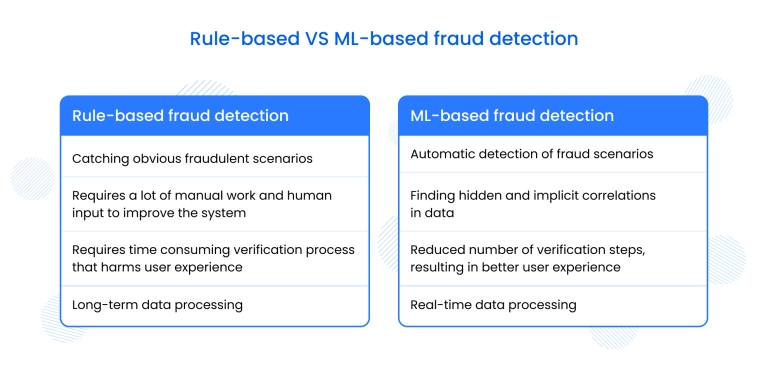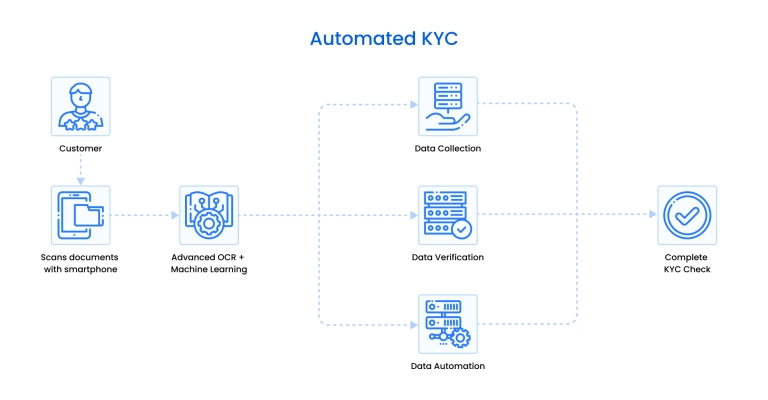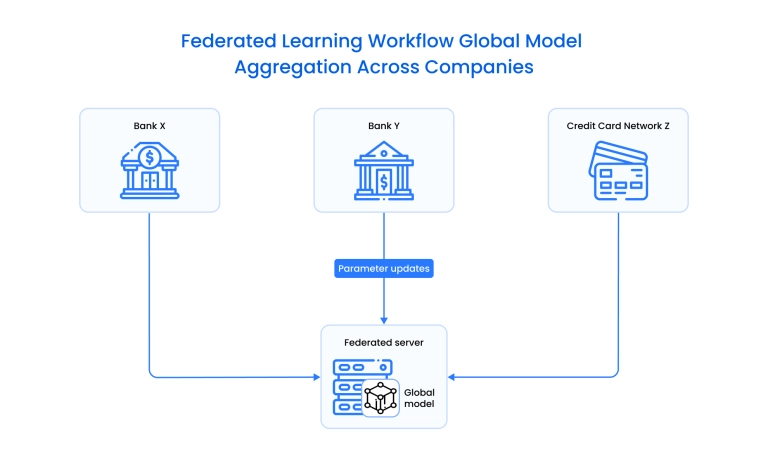Machine learning isn't just a buzzword in fintech – it's driving massive real-world impact.
The U.S. Treasury Department's technology-driven approach prevented and recovered over USD 4billion in fraud and improper payments in fiscal year 2024 alone – a six-fold increase from the previous year.
Meanwhile, Citi Global Perspectives and Solutions' report projects that AI could boost the entire banking industry's profits by USD 170 billion, or 9% , by 2028.
Ready to see how ML can work for your bank?
We'll walk you through practical strategies to automate tasks, prevent fraud, score credit fairly, and integrate new tools without tripping over compliance or legacy systems. You'll get actionable tips, learn about emerging trends like federated learning and transparent AI , and discover ways to keep your staff skilled, confident, and productive.
Machine learning in core banking operations
Let's be honest – keeping banking operations smooth and customer-friendly can feel exhausting. You're spinning plates: streamlining paperwork, fighting fraud, and ensuring every interaction counts. You want tools that do the heavy lifting, not just add more noise.
That's where machine learning shines. ML isn't magic, but used well, it's a serious upgrade. It's the difference between pushing a bike up a hill and cruising on an e-bike – more speed, less sweat, and time left over for what really matters.
Speed and smart: Everyday banking gets easier
Why spend hours sorting through repetitive tasks? ML can handle customer queries, payment sorting, and daily admin in seconds – not days. Think of it as your tireless back-office helper: always learning, never burning out.
It's more than saving time. ML solutions spot patterns as they go, flagging bottlenecks and freeing your team to work on bigger projects. You get smoother workflows and staff with the energy to focus on customers.
Fraud fighting: Staying ahead of scams
Money movement is risky business, and fraudsters keep upping their game. ML helps banks outpace them by scanning mountains of transaction data and spotting red flags instantly.
Predictive analytics acts like another set of eyes, catching unusual spending or unexpected account access. These models stay sharp, learning from new scams to send real alerts instead of endless false alarms.
Predictive analytics uses ensemble methods like Random Forest and Gradient Boosting to analyze transaction patterns, combining multiple decision trees to reduce false positives while maintaining high detection rates.
These models incorporate features like transaction velocity, merchant category changes, and geolocation anomalies to catch sophisticated fraud schemes.
The payoff? Fewer fraud losses, less manual review, and customers who trust you to protect their accounts.
Data Ingestion → Pattern Detection → Real-Time Alerts → Continuous Learning → Reduced Fraud
Fair credit scoring: Looking beyond the basics
Traditional credit scoring leaves lots of people behind. ML rewrites the rules by bringing in broader data: rent payments, monthly bills, and even verified online activity.
Modern ML credit models use gradient boosting algorithms like XGBoost or LightGBM to process thousands of alternative data points while maintaining interpretability through SHAP (SHapley Additive exPlanations) values. This allows banks to explain credit decisions to regulators while expanding access to underbanked populations.

Your approvals become fairer, opening up services for customers who were overlooked. As models learn and adapt, your risk assessment gets stronger over time.
Personalization that feels human
Nobody likes impersonal, one-size-fits-all banking. ML changes that by segmenting customers based on habits and needs, so your offers and services hit home.
Natural Language Processing (NLP) models, particularly transformer architectures like BERT variants fine-tuned for financial language, power modern chatbots.
These models understand context and intent, enabling conversational banking that feels natural while maintaining security through entity recognition and sentiment analysis.
Chatbots powered by ML handle everyday requests – balance checks, resets, scheduling – anytime. They use natural language skills to feel like real conversations, not robotic scripts. Your staff gets relief from routine work, and customers get answers, fast.
Automating paperwork and KYC
Document handling drags down even the best teams. ML tools use intelligent scanning and classification to turn stacks of paperwork into organized digital records in seconds.
Computer Vision models using Convolutional Neural Networks (CNNs) combined with Optical Character Recognition (OCR) can process documents with 99%+ accuracy. Advanced models like document understanding transformers can extract structured data from unstructured documents while flagging potential forgeries through image analysis.
KYC checks get a boost, too – catching mismatches and fakes automatically. Onboarding speeds up, compliance gets stronger, and staff aren't swamped by manual reviews.

Machine learning isn't smoke and mirrors – it's real savings, stress dropped, and sharper service. Whether tackling fraud, juggling accounts, or serving customers, ML is your tool for more innovative banking. If you need advice, a hands-on partner, or ongoing training, we're always ready to help – right when you need it.
Financial market innovations and regulation
Constant change is the new normal in financial services. Investment strategies shift fast, crime tactics evolve, and regulators raise the bar every year. You need smart tech and support, not just promises. Machine learning is central to our solutions: practical, understandable, and built for your team's success.
Let's see how ML, backed by our agency's partnership, can turn those headaches into wins.
Fast, smart trading and portfolio management
Markets move faster than spreadsheets. With ML, you get trading tools that spot patterns in real time, learning from price swings, news flashes, and even social media buzz.
High-frequency trading systems use deep reinforcement learning agents that adapt strategies in real-time. These models process market microstructure data, order book dynamics, and alternative data feeds to make split-second decisions.
Portfolio optimization leverages mean-variance optimization enhanced with machine learning to handle non-linear risk factors and regime changes.
Algorithm-based trading helps you catch opportunities missed by manual analysis. Portfolio optimization runs thousands of "what-if" scenarios to balance risk and reward without guesswork.
Forecasting is sharper, too. Imagine real-time probability scores and scenario alerts, turning market jitters into actionable plans.
Our approach: Binariks joins forces with your team, clarifying goals and explaining results in simple language. ML isn't a mystery here – it's your new daily tool.
Smarter defense against financial crime
Blocking money launderers is tougher every year. Old systems catch the basics but miss subtle patterns. With ML, risk checks adapt – instantly spotting shifts in customer behavior, odd transaction routes, and new vendors.
Anti-Money Laundering (AML) systems now use graph neural networks to analyze transaction networks, identifying suspicious patterns across multiple degrees of separation.
Unsupervised anomaly detection algorithms like Isolation Forest and One-Class SVM continuously learn normal behavior patterns, adapting to new laundering techniques without requiring labeled training data.
Instead of flat risk scores, you get daily updates matched with current threats. Fewer false positives free up your staff and help dodge costly fines.
Advanced security: Biometrics and real-time monitoring
Cyber risks touch every part of your business now. ML-powered security works ahead of the curve, not just in reaction.
Behavioral biometrics use recurrent neural networks (RNNs) to analyze typing patterns, mouse movements, and touchscreen gestures, creating unique user profiles. These models can detect account takeovers within seconds of login, even when traditional credentials are compromised.
Biometric screening uses fingerprints, faces, and voice patterns to spot impostors, not just regular logins. Intrusion detection learns normal activity, so anything out of place gets flagged instantly.
Adaptive monitoring keeps getting better with new data, tightening defenses when threats spike and easing back during slow periods.
We stand by you: We cover the tech setup and provide guidance for your team, helping you respond fast without drowning in confusing alerts.
ML adoption: How others stack up
Banks lead in some ML areas, especially financial fraud detection and risk scoring. However, many still struggle to move from pilot projects to daily use. Insurers focus on claims and customer service, which are slowed down by regulations and old systems. Asset managers ride high on algorithmic trading but often lack deep tech teams.
Retailers use ML to tailor sales, often running ahead of banks. Healthcare wins in diagnostics but remains limited by privacy rules.
Why this helps you: Knowing where your industry stands lets you grab quick wins and invest smart. Binariks' experts bring lessons from other sectors, helping you sidestep common mistakes and build ML that fits your market.
ML in banking: Implementation strategies that work
ML projects often feel overwhelming. You want practical answers and a routine that fits, not hype or jargon. Our aim? Doing what matters, step by step.
Setting goals and sorting data
- Start with simple, measurable targets – cutting fraud, speeding up approvals, or making credit scoring fairer.
- Data quality is paramount. Implement automated data validation pipelines using tools like Apache Airflow or Kubeflow to ensure consistent data preprocessing. Feature engineering should follow banking domain knowledge – for credit scoring, features like debt-to-income ratios and payment velocity often outperform complex derived features.
- Pick ML algorithms that match your problem – not just what's new. Decision trees work well for fast transaction checks, and neural networks shine for understanding customers. The key is finding the right fit, not chasing tech trends.
- Model selection should prioritize interpretability in regulated environments. Tree-based models (Random Forest, XGBoost) offer good performance with built-in feature importance. For complex patterns, use ensemble methods that combine interpretable base models rather than black-box deep learning approaches.
Common obstacles in ML rollout
Legacy systems can get in the way – they're often slow and brittle. Data privacy rules mean every new tool needs to respect laws like GDPR and industry standards or risk trust and big penalties.
Technical debt in legacy systems often requires API abstraction layers and microservices architecture to enable ML integration. Consider implementing feature stores using platforms like Feast or Tecton to serve real-time features to both legacy and modern systems consistently.
Regulatory demands keep shifting. You need models that make decisions you can explain, audit, and defend, not just a black box
Implement Model Risk Management (MRM) frameworks from the start. This includes model documentation, validation testing, performance monitoring, and challenger models. Use tools like MLflow or Weights & Biases for experiment tracking and model lineage.
Keeping ML in good shape
After launch, keep tabs on your models. Banking data shifts quickly so that models can drift out of sync.
Model monitoring should track four types of drift: data drift (input distribution changes), concept drift (relationship between features and targets changes), prediction drift (output distribution changes), and performance drift (accuracy degradation). Implement automated retraining pipelines triggered by drift detection thresholds.
Set up dashboards and regular alerts for performance. Retrain models as new patterns emerge – don't wait for a crisis to update.
Getting teams on board
Tech alone isn't enough – people make ML projects work. Communicate clearly, invite feedback, and provide incentives for learning new skills.
Create support lines for staff using new systems, pair experienced tech leaders with banking experts for mentorship, and reward curiosity and effort.
Machine Learning expertise you can trust
ML trends and ethics: What's next, and what matters
ML is moving fast. It's tricky to keep up and avoid the pitfalls. Here's what's heating up, what risks you'll face, and how to get the most out of new tech.
New frontiers: Federated learning, edge computing, and explainable AI
With federated learning , you train ML models on devices instead of a central server. It's safer for sensitive data and helpful for banking and healthcare. Each device improves accuracy without sharing raw records.
Explainable, a daptive AI lets you see why decisions happen, boosting transparency and trust. Whether it's loan approvals or suspicious transactions, you can check the reasoning in real time.
Edge computing brings analysis right to where it happens, like at ATMs or branch terminals. Fraud checks and approvals run on the spot, with no delay.

Facing bias and building trust
Bias in ML isn't abstract – it affects real lives. Credit scoring models sometimes miss context, unfairly denying applicants. Fixing this means:
- Auditing regularly for data gaps
- Building transparent models and sharing logic
- Retraining as new data arrives, not just once
In 2019, a widely used clinical algorithm deciding which patients need care was showing racial bias by assigning care not based on health but on spending history. Black patients had to be deemed much sicker than white patients to be recommended for the same care.
Once flagged, data use and outcome measures shifted.
Implement bias detection frameworks that test for disparate impact across protected categories. Use techniques like adversarial debiasing during training and post-processing calibration to ensure fair outcomes. Regular bias audits should be part of your model governance process.
Final thoughts: Your ML journey starts with strategic planning
The banking industry stands at a crossroads. While ML technology has matured significantly, success depends on strategic implementation rather than technology adoption alone.
The organizations that will lead the next decade are those that view AI/ML not as a silver bullet, but as a systematic approach to solving well-defined business problems.
The reality check:
Most banks struggle not with choosing algorithms, but with data quality, change management, and scaling beyond pilot projects. The winners focus on building robust data infrastructure , establishing clear governance frameworks, and developing organizational capabilities that can adapt as technology evolves.
The question isn't whether your bank will adopt ML – it's whether you'll do it strategically with the right partners, or reactively under competitive pressure. The window for strategic advantage is open now, but it won't stay open forever.
Share


